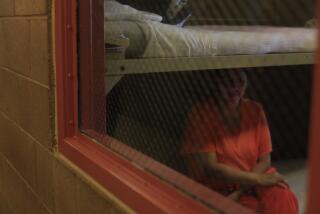Baby survives 150-degree car; ‘out of sight, out of mind’
- Share via
Some might call it miraculous. An Indiana toddler left in a locked car in near-record heat has survived temperatures that could have reached as high as 150 degrees Fahrenheit, one expert says.
At 158 degrees, you can cook an egg.
Two children were left in extremely hot cars over the weekend in Indiana in separate incidents.
One 4-month-old girl did not survive her ordeal. Amid the lengthy heat wave that has shattered temperature records across the Midwest, the infant was found locked in a car Saturday in Indianapolis, according to local media. Temperatures in the city that day reached 105 degrees. She was taken to a local hospital, where she was pronounced dead.
The second child, 16 months old, suffered seizures after being rescued from the car in which she was locked. She was in critical condition, according to the Associated Press, but by Sunday her condition had improved and she was released from an Indianapolis hospital.
“I was frankly very surprised,” said Jan Null, a lecturer at San Francisco State University who collects data on the hyperthermia deaths of children in vehicles.
Rescuers said the temperature within the car was 124 degrees -- but that was after they broke the glass, Null said. At 105 degrees outside, the temperature within the closed car would have been “more like 145 or 150,” he said Monday in an interview with the Los Angeles Times.
The death of the infant brings the total number of U.S. vehicular hyperthermia deaths of children left in cars this year to 10, according to Null. “These numbers are conservative,” he said, “because there are cases that never get any media attention.”
Null, a former meteorologist with the National Weather Service, tracks electronic news reports to gather his data, which he’s been collecting annually since 1998. In 2005, his annual study was published in the journal Pediatrics.
How could the 16-month-old have survived the 150-degree heat?
“Some of that may just be age,” Null said. “A more mature body can perspire more. ... A lot of it is physiology, some of it is just plain physics -- where they are in the car.” Is the child strapped into a car seat that has placed him or her in direct sunlight? How well hydrated is the child?
It does not have to be very hot outside for a child to die within a closed car. Null recalled the death of a child in the Bay Area on June 8, 2009. “It was a relatively cool day, a nice sea breeze, the temperature was in the upper 60s.”
Even on cool days, “cars heat up, and then they retain their heat,” Null said. The child who died that day at a BART station was 4 months old.
Among Null’s research is this fact: “In the most recent three-year period of 2009-2011, when almost all young children are now placed in back seats instead of front seats, there have been at least 118 known fatalities from hyperthermia ... a ten-fold increase from the rate of the early 1990s.”
So does this suggest that you should not put your child in the back seat?
No. Null said the data should not be construed as a recommendation to put your child in the front seat -- where air bags pose a deadly danger. And the sample on which the data are based is too small to prove a statistical correlation.
“But most people would see,” he said, “there’s at least some correlation there.”
People have busy lifestyles, he said, and “out of sight, out of mind.”
In the case of the 16-month-old girl rescued Saturday, her mother, 30-year-old Meg Trueblood, had gone into a clothing store, leaving her baby in the car. She was arrested on a preliminary charge of neglect, according to the Associated Press, and was later released on bond.
The 18-year-old father of the 4-month-old who died, Joshua Stryzanski, was reportedly being held on a charge of neglect of a dependent resulting in death.
ALSO:
Great white stalks Cape Cod kayaker
‘Fifty Shades’ sex trilogy dominate bestsellers
More to Read
Sign up for Essential California
The most important California stories and recommendations in your inbox every morning.
You may occasionally receive promotional content from the Los Angeles Times.










